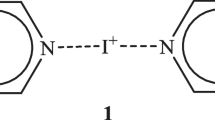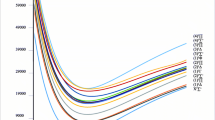Abstract
This paper deals with the understanding at a first-principles level of the nuclear quadrupole interaction (NQI) parameters of solid chlorine, bromine and iodine as well as the intermolecular binding of these molecules in the solid. The electronic structure investigations that we have carried out to study these properties of the solid halogens are based on the Hartree–Fock Cluster approach using the Roothaan variational procedure with electron correlation effects included using many-body perturbation theory with the empty orbitals used in the perturbation theory investigations for the excited states. The results of our investigations provide good agreement with the measured NQI parameters primarily from the Hartree–Fock one electron wave-functions with many-body effects making minor contributions. The binding (dissociation) energies for the molecules with the solid state environment on the other hand arises from intermolecular many body effects identified as the Van der Waals attraction with one-electron Hartree–Fock contribution being repulsive in nature.
Similar content being viewed by others
References
Dubey, A., Saha, H.P., Pink, R.H., Badu, S.R., Mahato, D.N., Scheicher, R.H., Mahanti, M.K., Chow, L., Das, T.P.: Nuclear quadrupole interactions and electronic structure of BF3·H2O complex. Hyperfine Interact. (this issue)
Das, T.P., Hahn, E.L.: Nuclear Quadrupole Resonance Spectroscopy, pp. 173–179. Academic, New York (1958)
Das, T.P.: Hartree-fock cluster procedure for study of hyperfine properties of condensed matter systems. In: Kaplan, T.A., Mahanti, S.D. (eds.) Electronic Properties of Solids Using Cluster Methods, pp. 1–28. Plenum, New York (1995)
Tsukada, K.: Zeeman splitting of the nuclear quadrupole resonance line of iodine. J. Phys. Soc. Japan 11, 956–963 (1956). Also: Das, T.P, Hahn, E.L.: Ref. [2]
Das, T.P.: Theory of origin of hyperfine interactions in atomic systems. Hyperfine Interact. 34, 149–165 (1987)
Gaussian, 03, Revision, C.02, Frisch, M.J., Trucks, G.W., Schlegel, H.B., Scuseria, G.E., Robb, M.A., Cheeseman, J.R., Montgomery, Jr., J.A., Vreven, T., Kudin, K.N., Burant, J.C., Millam, J.M., Iyengar, S.S., Tomasi, J., Barone, V., Mennucci, B., Cossi, M., Scalmani, G., Rega, N., Petersson, G.A., Nakatsuji, H., Hada, M., Ehara, M., Toyota, K., Fukuda, R., Hasegawa, J., Ishida, M., Nakajima, T., Honda, Y., Kitao, O., Nakai, H., Klene, M., Li, X., Knox, J.E., Hratchian, H.P., Cross, J.B., Bakken, V., Adamo, C., Jaramillo, J., Gomperts, R., Stratmann, R.E., Yazyev, O., Austin, A.J., Cammi, R., Pomelli, C., Ochterski, J.W., Ayala, P.Y., Morokuma, K., Voth, G.A., Salvador, P., Dannenberg, J.J., Zakrzewski, V.G., Dapprich, S., Daniels, A.D., Strain, M.C., Farkas, O., Malick, D.K., Rabuck, A.D., Raghavachari, K., Foresman, J.B., Ortiz, J.V., Cui, Q., Baboul, A.G., Clifford, S., Cioslowski, J., Stefanov, B.B., Liu, G., Liashenko, A., Piskorz, P., Komaromi, I., Martin, R.L., Fox, D.J., Keith, T., Al-Laham, M.A., Peng, C.Y., Nanayakkara, A., Challacombe, M., Gill, P.M.W., Johnson, B., Chen, W., Wong, M.W., Gonzalez, C., Pople, J.A.: Gaussian Inc., Wallingford CT (2004)
Raghavan, P.: Table of nuclear moments. At. Data Nucl. Data Tables 42, 189–291 (1989)
Haas, H., Petrilli, H.M.: Quadrupole moments of the halogen nuclei. Phys. Rev. B. 61, 13588–13592 (2000)
Blaha, P., Schwarz, K.: Solid state effects in the molecular crystals of Cl2, Br2, and I2. J. Mol. Struct., Theochem 261, 355–365 (1992)
Singh, D.J.: Plane Waves, Pseudo Potentials and the LAPW Method. Kluwer, Boston (1994)
Author information
Authors and Affiliations
Corresponding author
Rights and permissions
About this article
Cite this article
Aryal, M.M., Mishra, D.R., Paudyal, D.D. et al. Understanding of nuclear quadrupole interactions of 35Cl, 79Br and 129I and binding energies of solid halogens at first-principles level. Hyperfine Interact 176, 51–57 (2007). https://doi.org/10.1007/s10751-008-9633-9
Published:
Issue Date:
DOI: https://doi.org/10.1007/s10751-008-9633-9




